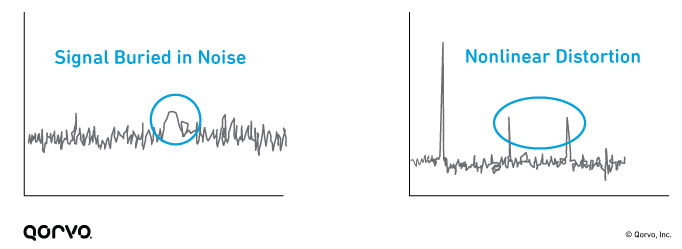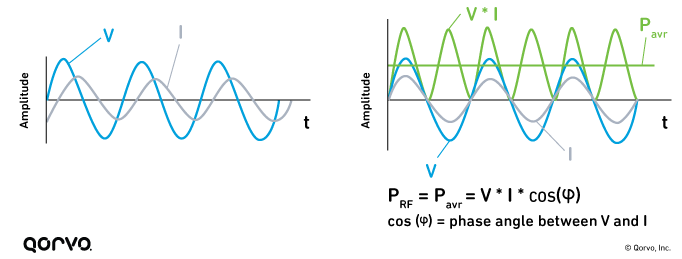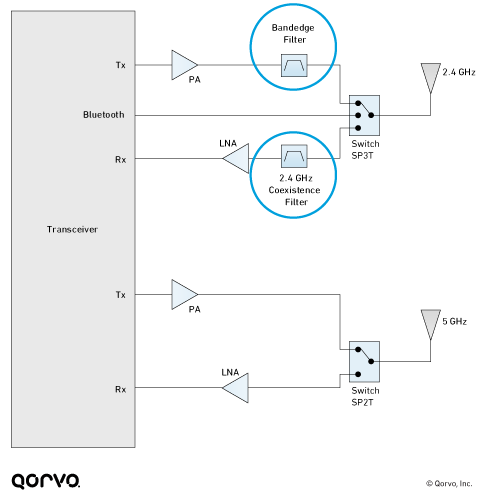Continuing advances in wireless connectivity such as 5G are increasing consumer expectations, putting more pressure on Wi-Fi manufacturers to up their game by developing new products that support the newest, fastest Wi-Fi standards. Accordingly, Wi-Fi routers have advanced from the single-band, two-antenna systems of a decade ago to dual-band, multi-antenna systems with multiple-input-multiple-output (MIMO) technology. Although these advances provide unprecedented performance, reliability and capacity, they also create considerable design challenges. As Wi-Fi routers pack more RF chains and other features into smaller units, it is becoming increasingly important to optimize power consumption and avoid costly design modifications due to excess heat production. To optimize the delicate balance between performance, power consumption and cost, it is essential to select RF components from the perspective of their impact on overall system performance and power efficiency. Products such as highly integrated modules and high-efficiency PAs can help solve those challenges.
Introduction
Wi-Fi device manufacturers continuously aim to build next-generation products that deliver a compelling user experience by combining the best range, speed, capacity and reliability with a compact, sleek design. To achieve this, system designers need to carefully balance component performance, cost, power consumption, and industrial design requirements.
A Look at System Power
Consumers, OEMs and designers like Wi-Fi routers that deliver the highest RF power output – providing the fastest data rates and greatest range — while consuming the least amount of energy. But managing power consumption is becoming more challenging with each new Wi-Fi standard, as devices become more complex and include more RF chains to increase performance and capacity through features such as MIMO. It’s well known that the RF receive and transmit sections of a typical 802.11 Wi-Fi system consume the largest share of system power, while the data processing section consumes much less energy (Figure 1). Design expertise as well as the below tips can help achieve a successful system design.
Figure 1. Power Consumption for 802.11 Conventional and Low-Power Unit

When analyzing system power consumption, many Wi-Fi system design engineers tend to think about the voltage or current used by the components within the system. However, when considering power consumption and RF power output in Wi-Fi systems, it is more helpful to think in terms of watts. In electronics, power (measured in watts) is the amount of energy transferred per unit of time.
The RF output power level (watts) of each component within the system is one of the most important considerations when designing a Wi-Fi device. Each component in an RF chain must receive the correct signal power level from the preceding component in the chain, and it must pass the correct signal level on to the next component. If the signal power level is too low, the signal may be buried in noise. If the signal power level is too high, the performance will be nonlinear, resulting in distortion or even damage to components (Figure 2).
Figure 2. RF Power Output Signal Levels

At Wi-Fi frequencies, power is more easily measured, easier to understand, and a more useful metric than voltage or current. While voltage and current measurements are straightforward at lower frequencies, they become difficult and impractical at frequencies around 1 GHz and above. One key reason is that voltage and current can vary depending on the position along a lossless transmission line, due to standing waves produced by the interaction of incident and reflected traveling waves. In contrast, the average power remains constant along the transmission line (Figure 3). Therefore, direct power measurements are typically the most practical approach for applications in these higher frequency ranges, including Wi-Fi (2.4 GHz, 5 GHz or 6 GHz).
Figure 3. Deep Dive into RF Power

The Side Effects of Power Consumption
A negative side effect of power consumption is heat. The higher the wattage of a system or component, the more heat it will produce. Heat can cause a range of problems in electronics. If a component or system design is too hot, the detrimental effects can include:
- Lower system reliability. If components run too hot, they can degrade faster, which reduces their lifetime.
- Higher unit cost. Engineers may need to add costly heat-sinks, fans or package modifications to dissipate the heat.
- Poor RF performance. Large temperature swings or high temperatures can adversely affect RF performance. Keeping the unit temperature relatively stable within a moderate range can mitigate the problem.
RF Power and Interference Problems
Though high RF power output is generally considered a good thing, it can also produce negative side-effects in the form of increased out-of-band interference . In addition to Wi-Fi, a typical home router may also simultaneously support other standards that use frequencies in the 2.4 GHz range, such as Bluetooth and Thread. High output power on any of these increases the chance of interference with the others, as well as the risk of interference with nearby systems using the same or adjacent frequencies — including cellular devices such as smartphones. If not mitigated, this interference causes problems for all affected devices, including reduced system performance.
To reduce the potential for interference, engineers insert RF filters into the RF transmit and receive chains in the device (Figure 4). RF filters allow only the desired frequencies to pass through, while blocking adjacent and other unwanted frequencies. However, it is important to select filters carefully and use them judiciously, as these components add insertion loss, which means the PA may need to drive more output power to compensate. This causes increased power consumption and thermal concerns. A further concern is that the frequency response of some RF filters can shift as the temperature changes. Known as temperature drift, this tendency can undermine the effectiveness of the filters and reduce system performance. To avoid this problem, it is necessary to use filters that are designed to maintain a stable frequency response across a wide temperature range.
Figure 4. Dual-Band Wi-Fi with RF Filtering

Solving the Problem
So how do we get the best Wi-Fi range and overall system performance with the lowest possible power consumption? There are several ways to optimize the RF section of the Wi-Fi device to achieve these goals.
- Integration. Fully integrated RF Front-End (RFFE) products offer higher performance while reducing time-to-market and overall design time. These integrated products combine multiple components along the RF chain, such as PAs, switches and filters, into a single package. Because they provide higher performance due to reduced insertion loss, it is easier to maximize the RF output power of the system while minimizing power consumption.
- Highly efficient PAs and other RF components. PA power efficiency makes a big difference, because PAs are responsible for much of the power consumption of the Wi-Fi RFFE. By choosing the most efficient PAs, you can increase performance while mitigating thermal problems and avoiding the possible added expense of heat sinks. But it’s also important to consider efficiency and power consumption when selecting other RFFE components. Seeking out components and modules that meet system requirements but consume the least energy can help to reduce the need for costly, time-consuming adaptions to the Wi-Fi system, such as heat sinks, fans, and package modifications.
- Low power operation. Front-end modules can be designed to support operation in two modes: a low-power and a high-power mode. This can help to reduce overall power consumption of the Wi-Fi unit. For example, when a user is close to the unit, lower RF signal power may be sufficient to provide a reliable data connection. When the user is farther away, more output power is required.
Summary
As Wi-Fi consumer premise equipment (CPE) continues to advance in performance and capabilities, power consumption should be at the forefront of design considerations. Wi-Fi CPE trends including MIMO and support for additional standards such as Thread and Bluetooth create unique design challenges, as engineers seek to pack more functionality into smaller, sleeker designs while meeting stringent performance criteria and minimizing power consumption. It is therefore essential to select RF components from the perspective of their impact on overall system performance and power consumption. Choosing RF components with the lowest power requirements and highest performance can save valuable design and development time, avoid the need for costly modifications, and simplify device certification.
